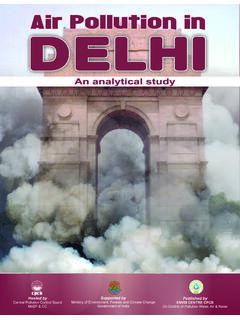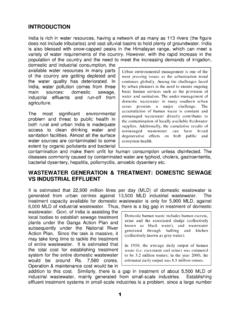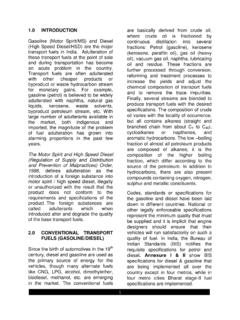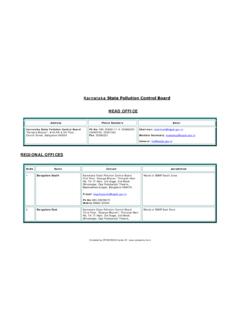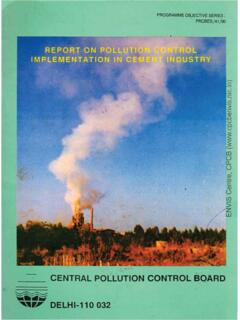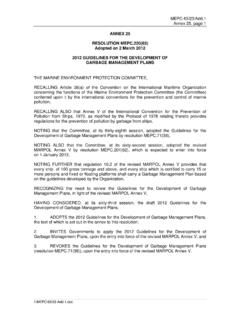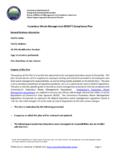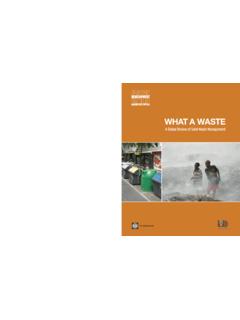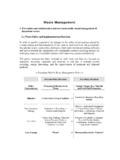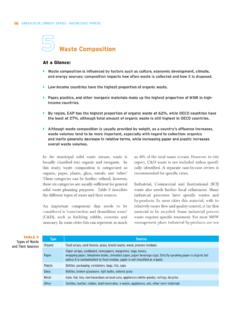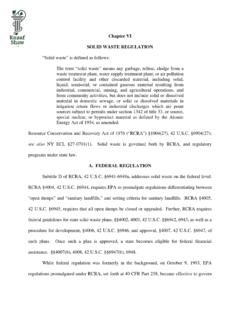Transcription of Central Pollution Control Board - CPCB ENVIS
1 Central Pollution Control [9/6/2012 11:04:22 AM] Growing ProblemsCharacteristics of GarbagePresent Management PracticesCommunity ParticipationsInvolvement of NGOsRole of RagpickersRecyclingWealth from Wastes : TechnologiesNational Plans for ManagementFeatures of the Existing LawsLitigationsPublic OpinionRole of Pollution Control BoardA tale of TrashFinancial aspectsCPCB PublicationsCentral Pollution Control [9/6/2012 11:04:23 AM] Contents Archives HomeThe 'PARIVESH' has entered the fourth year, Through the 'PARIVESH', we sharedinformation on various aspects of Pollution to strengthen our linkage with all concernedfor the cause of environmental protection. The information related to status and trends ofpollution; policies and laws; important events and initiatives; research & development;waste management; environmental planning and zoning atlas; Pollution Control norms andtheir enforcements etc.
2 Have been shared. I am thankful to Dr. Chakrabarti, MemberSociety, Shri Jindal and the ENVIS team for regularly bringing out the thematicissues of the PARIVESH which have been well received by the Present issue of the PARIVESH deals with Municipal Solid Wastes ( garbage ). Theprimary responsibility for collection, transportation, disposal and utilisation of garbage iswith the civic authorities. However, for various reasons, these authorities have beenfinding it difficult to cope up with this task, the consequences of which are evidentthrough Pollution and health by my colleagues, Dr Avinash Akolkar, Shri Mahendra Pandey and Shri SunilAnand, this issue of the PARIVESH provides an overview of the existing practices vis-a-vis possibilities for better management of municipal solid wastes, through adoption ofinnovative approaches and public participations in reducing, recycling and reuse ofwastes.
3 (Dilip Biswas)Chairman, CPCBC entral Pollution Control [9/6/2012 11:04:24 AM]MUNICIPAL SOLID WASTESGROWING PROBLEMS :Solid wastes generated by domestic, commercial and industrial activities are often indiscriminately management of such wastes leads to serious environmental problems. The problems are already acute incities and towns, as the disposal facilities are not keeping pace with the quantum of waste being generated. It isvery common to find large heaps of garbage in disorganized manner at every nook and corner of the cities. In sanitary method being adopted for disposal of solid wastes is a serious health concern. Particularly, during rainyseason, run-off and high humid conditions increase the health hazards.
4 The landfill sites, which are not wellmaintained, are prone to groundwater contamination due to leachate percolation. Open dumping of garbage servesas breeding ground for disease vectors such as flies, mosquitoes, cockroaches, rats and other pests. High risks of spreading diseases like typhoid, cholera, dysentery, yellow fever, encephalitis, plague and dengue fevermay not be ruled out. There are three major steps involved in the management of garbage viz. collection,transportation and disposal (CTD). The collection methods currently adopted by the civic authorities are primitive and lacking in specific standards orguidelines, which are required to be laid for designing and sitting of collection of garbage is carried out using old outdated trucks, tippers and refuse collectors.
5 Inadequacy oftransportation fleet and frequent breakdown of vehicles are the major hardship in proper collection of of municipal solid wastes is generally done through landfilling. Most of the cities have acquired land forlandfilling years ago, and now these sites are over-used. Acquisition of the new sites is a tough task for to ContentCentral Pollution Control [9/6/2012 11:04:25 AM]MUNICIPAL SOLID WASTESCHARACTERISTICS OF garbage :Quantity It is estimated that solid waste generated in small, medium and large cities and towns is about kg, kgand kg per capita per day respectively. CPCB sponsored a survey to ascertain the status of municipal solid waste disposal in metro cities, Class-I cities andClass-II towns of India.
6 The survey was conducted by the Environment Protection Training Research Institute(EPTRI), Hyderabad. As per the survey, the quantities of municipal solid wastes generation in metro cities arepresented in Table1. Table 1 Municipal Solid Wastes Generation in Metro PopulationMunicipal SolidWastes (tpd)Per capita waste(kg/day) ,87,61041,30,28810,62,77196,43,21147,52, 9748,16,32184,19,08440,98,73410,91,67414 ,58,48318,74,4096,70,00916,19,1151,6832, 0005463,6923,1243504,0001,5663505801,200 3471, Pollution Control [9/6/2012 11:04:25 AM] ,42,7401,22,88,5199,40,98916,24,7529,17, 24322,44,19614,98,81710,31,34610,30,8637 ,52,0374005, The composition of garbage in India indicates lower organic matter and high ash or dust contents.
7 It has beenestimated that recyclable content in solid wastes varies from 13 to 20% and combustible material is about 80-85%.A typical composition of municipal solid waste is given below. DescriptionPercent by weightVegetable, , , to ContentCentral Pollution Control [9/6/2012 11:04:26 AM]MUNICIPAL SOLID WASTESPRESENT MANAGEMENT PRACTICES :Collection of garbage garbage is generated from residential and commercial complexes. Current practices in residential areas for collectionof garbage differ from city to city and even within the city. Door to door collection is not widely practiced. A fewresidential societies hire private scavenging staff for door-to-door collection of solid waste.
8 The local authorities do not have proper provision to collect waste from narrow residential and commercial lanes, andin areas with high traffic. The slums and squatters in cities also create in sanitary conditions. Open defecation and disposal of sewage andgarbage from such settlements need proper attention. Similarly, operation of dairy related activities in residentialareas cause nuisance. Cow-dung and other waste is not properly managed. Vendors selling eatables, vegetables,fruits etc. also thro their wastes recklessly, which need to be regulated Collection Centres The findings of survey carried out by CPCB indicate that in some of the cities, no norms/guidelines have beenfollowed in setting up of waste collection centers.
9 Each city has its own system for setting up of waste collectioncenters, which are still using primitive methods. In some cities, both the collection and transportation of waste iddone by using mechanized bins. At primary level, the waste is collected from communities in a smaller bin, which isthen transported, to larger bins known as secondary collection facility. Maintenance of such waste collection centersis also an important aspect which needs proper attention. Transportation of garbage Transportation of waste from collection centers to final disposal site is another important step in the management ofgarbage. It has been estimated that approximately 60% of waste is collected for transportation to the disposal sitesand the main constraints are: non-availability of sufficient transportation fleet; frequent breakdown of vehicles; andabsenteeism of crew etc.
10 The garbage during transportation to the disposal site is exposed to the open conditionsthus causing public nuisance. The vehicles carrying garbage should be covered. Loading of garbage for transportation is done manually. Workers are exposed to the garbage . During manual loading,6-8 workers are deployed on each truck. In smaller towns, tractor-trailers are commonly used and at times, animaldrawn carts are also being used. In some cases, front-end loaders are also used, though; the receptacles are notwell designed to suit such of waste should be done on everyday basis throughout the year. Vehicles and equipment, to transportthe waste should synchronize with primary and secondary collection centers.

